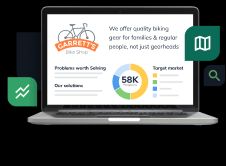
Free Download
Balance Sheet Statement Template
Determine your overall financial outlook by tracking your assets and liabilities with a well-organized balance sheet.
Or start forecasting with expert support in LivePlan.
Available formats:


Downloads: 1,261
Why use this balance sheet template?
Fill-in-the-blanks
No need to mess with formatting or formulas; this balance sheet template is built for you to just start adding your numbers.
Preview a completed statement
View a filled in example of what your final balance sheet could look like.
Completely customizable
This financial template is yours to edit and adjust to fit your needs.
Built by experts
Run your business confident that you have a working balance sheet built by the small business experts here at LivePlan.
The balance sheet is one of the key financial statements that you should review regularly—at least once a month.
Balance sheet definition
Your balance sheet shows the current financial state of your company and summarizes what you own (your assets), what you owe (your liabilities), and the money you’ve invested into your business, plus profits (your equity).
Unlike the other two primary financial statements (your profit and loss and cash flow statement) which span a period of time such as a month, quarter, or year, the balance sheet tells you how your business is doing at a specific point in time.
Having an accurate balance sheet is fundamental to every business. It is the primary document an investor or lender will want to see to understand your business’s health and value. When you review it regularly, it also provides some key information that will help you make better strategic spending and growth decisions.
Balance sheet formula
The balance sheet always has to balance—as the name suggests—with assets (like cash and inventory) on one side, and liabilities (like accounts payable) and equity on the other.
The formula for every balance sheet is:
Assets = Liabilities + Equity
Balance sheet analysis: How to read and understand it
Regularly reviewing your balance sheet—also called balance sheet analysis—will help you spot potential cash issues, and understand the state of your business’s investing and financing activities, whether you’re seeking funding from lenders or investors, or you’re trying to make smart growth decisions.
There are also a number of useful ratios you can pull from balance sheet data that help you gauge your cash on hand against your financial obligations, and help you compare your business’s health with industry benchmarks.
To learn more about what a balance sheet is and what it can tell you about the current state of your business, check out this article: What Is a Balance Sheet, and How Do You Read It?
Frequently asked questions
A balance sheet contains three main components: assets, liabilities, and equity. Assets are what the company owns, liabilities are what it owes, and equity represents the owner’s stake in the business.
A balance sheet is important because it provides a snapshot of your business's financial position at a specific point in time. It helps stakeholders assess the company's liquidity, financial health, and ability to meet its obligations.
Try LivePlan today
Totally risk free. 35-day money-back guarantee.



